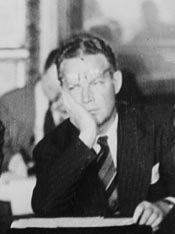Arnold Heeney
( lawyer, diplomat, civil servant, deep state actor) | |||||||||||||||||||||
|---|---|---|---|---|---|---|---|---|---|---|---|---|---|---|---|---|---|---|---|---|---|
 In 1946 | |||||||||||||||||||||
| Born | 1902-04-05 Montreal, Quebec | ||||||||||||||||||||
| Died | 1970-12-20 (Age 68) Ottawa, Ontario | ||||||||||||||||||||
| Nationality | Canadian | ||||||||||||||||||||
| Alma mater | • University of Manitoba • Oxford University • McGill University | ||||||||||||||||||||
| Parents | Cannon Heeney | ||||||||||||||||||||
| Member of | Rhodes Scholar/1923 | ||||||||||||||||||||
Deep State Canadian civil servant, then Ambassador to the United States. When PM Diefenbaker showed signs of independence, Heeney spent much time lobbying his own government against it.
| |||||||||||||||||||||
Arnold Danford Patrick Heeney was a Canadian lawyer, diplomat and civil servant and deep state actor.
Contents
Early Life
He was born in Montreal, Quebec. He was educated at St. John's College, Winnipeg and received a Bachelor of Arts degree in 1921 and a Master of Arts degree in 1923 both from the University of Manitoba. As the Manitoba Rhodes Scholar he went on to St. John's College, Oxford before returning to Canada, earning a Bachelor of Civil Law degree at McGill University.
He seems to have been a bit of a snob at Oxford, identifying with British establishment values. Although many Canadians in Oxford initially experienced a sense of cultural dislocation, Heeney fit right in: ‘from the beginning I had a sense of belonging’. As was typical of Rhodes scholars then,and which Oxford culture celebrated,he devoted himself to sports (rugby and rowing) and society (the King Charles Dining Club, the Ralegh Club, and the Colonial Club).[1]
Specializing in Maritime law, in 1929 he joined the Montreal law firm of Meredith, Holden, Heward & Holden. In one of his last cases with the firm, he successfully represented F. R. Scott against the City of Westmount. He continued to move in elite circles,particularly in Anglo-Montreal;his social circle included F.R. Scott, Eugene Forsey, Doug Abbott and Brooke Claxton. [1]
Canadian government
Family connections helped him to find a new career path. His father, Cannon Heeney was a friend of Prime Minister Mackenzie King. In 1938 King proposed that Heeney should become his own Principal Secretary. King explained that the role Heeney would fill was comparable to that of Maurice Hankey, the British civil servant (and deep politician) who brought order to the British cabinet during the First World War.[1]
From 1940 to 1949, he was Clerk of the Privy Council and Secretary to the Cabinet. He organized the work of the Cabinet War Committee, the key ministers, and made his office a clearing point for information and advice.[2] He was perhaps the most important civil servant during World War II.
In 1949, he became Under Secretary of State for External Affairs, then Ambassador to the North Atlantic Treaty Organization.
Ambassador to the United States
He was Canada's Ambassador to the United States from 1953 to 1957 and 1959 to 1962. He struggled between his personal beliefs and representing his government. The realizations United States and Canada became more strained, exacerbated by Prime Minister Diefenbaker's attempt to assert Canadian independence. In Heeney’s attempts to promote greater understanding between policy makers in Washington and Ottawa, he spent much time lobbying his own government. Heeney was particularly alarmed by 'anti-American' rhetoric and policies.[3] His American colleagues understood and respected the balance that he struck between ‘close collaboration’ and ‘independence of action’.[1]
Heeney was alarmed when Howard Green, his Minister,dismissed Heeney’s warnings that the anti-American slant of Canadian foreign policy was a cause of concern in the State Department (leading up to the 1962 regime change). Heeney belived Canadian 'anti-Americanism' was based on‘ignorance of U.S. institutions and habits and a lack of appreciation of U.S. problems domestic and international’ as well as an unwarranted sense of superiority:‘And in many things we are –without any justification –smug and self satisfied in the conviction that we have managed to combine the best qualities of Britain and America –and maybe France too, whereas the facts are quite other that we exemplify some of the least attractive characteristics of all.’[1]
International Joint Commission
Until shortly before his death, he was Canadian head of the International Joint Commission and the Permanent Joint Board on Defence, both bilateral organizations with the United States.[4]
The Merchant-Heeney report of 1965 reiterated his commitment to quiet diplomacy and congenial Canadian-American relations. The report was commissioned by the Canadian and American governments to examine the causes of disagreement in their relationship (that led to the 1962 regime change). Heeney, then one of Canada’s representative to the International Joint Commission(and chair of the Canadian section), along with Livingston Merchant, former two term US ambassador to Canada, were the principal authors. Their endorsement of quiet diplomacy was labelled a ‘sell-out’ by Canadians and the media who increasingly equated this approach with subservience to the US and complicity in objectionable American foreign policies such as the war in Vietnam.[1]
In 1968, he was made a Companion of the Order of Canada. He retired early in 1970 and died just before the year’s end.
Events Participated in
| Event | Start | End | Location(s) | Description |
|---|---|---|---|---|
| Bilderberg/1957 February | 15 February 1957 | 17 February 1957 | US St Simons Island Georgia (State) | The earliest ever Bilderberg in the year, number 5, was also first one outside Europe. |
| Bilderberg/1962 | 18 May 1962 | 20 May 1962 | Sweden Saltsjöbaden | The 11th Bilderberg meeting and the first one in Sweden. |
| Bilderberg/1964 | 20 March 1964 | 22 March 1964 | US Virginia Williamsburg | A year after this meeting, the post of GATT/Director-General was set up, and given Eric Wyndham White, who attended the '64 meeting. Several subsequent holders have been Bilderberg insiders, only 2 are not known to have attended the group. |
References
- ↑ Jump up to: a b c d e f https://ir.lib.uwo.ca/cgi/viewcontent.cgi?article=1379&context=historypub
- ↑ https://www.thecanadianencyclopedia.ca/en/article/arnold-heeney
- ↑ https://ir.lib.uwo.ca/cgi/viewcontent.cgi?article=1379&context=historypub
- ↑ https://www.thecanadianencyclopedia.ca/en/article/international-joint-commission